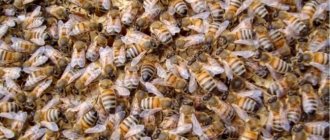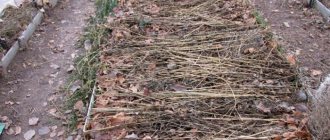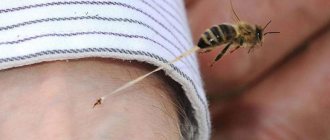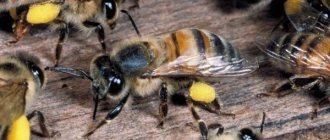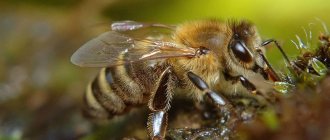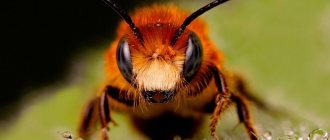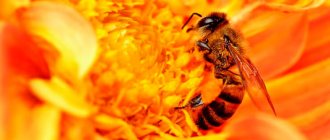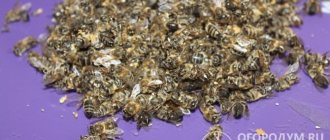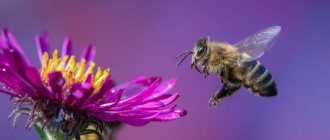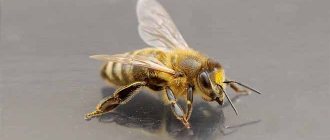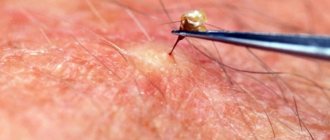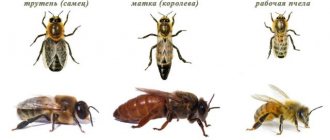Bees Blog Articles
Beekeeping
Economics of beekeeping
Beekeeping news in Russia
Beekeeping news in the world
Honey
Propolis
Bee bread
Zabrus
Royal jelly
In the world about bees
Apiary
Bees
News from honey fairs
From the history of beekeeping
- Preparing bees for winter
- Correct assembly of a bee nest for the winter by a beekeeper
- Nutrition of bee colonies in winter
- Feeding bees in winter
- Wintering bees in a hive outside
- Wintering of bees in omshanik
- Temperature in a bee club in winter
- Insulation and ventilation of a bee nest
- Principles for successful wintering
- Control of wintering of bees
- Video recommendations and tips for preparing bees for winter
Preparing bees for winter
Bees, unlike many other insects, do not hibernate in winter. As soon as they feel a natural stable drop in temperature and a decrease in daylight hours, they go into food saving mode. Moreover, they gradually expel the drones from the hive, since the queens are already inseminated. This behavior is explained by the fact that winter food reserves need to be made, but drones eat more food than bees.
Insects begin to prepare the honeycombs in the hive in a certain way. Nectar that is considered immature is transferred upward for ripening. Honey is also transferred to the upper part of the frames and is gradually filled from the top bar to the bottom and sides of the nesting frame. A winter club will subsequently be formed in the area cleared of brood. In general, the behavior of bees becomes more wary and aggressive. All their actions are aimed at preserving bees and food for the whole winter.
How to deal with mice in an apiary
Rodents cause great damage to beekeeping. Penetrating into the hives, they live there for a long period, feeding on beebread, honey, and dead bees. Mice in hives destroy honeycombs, destroy insulating material, and make nests.
Rodents pose a great threat to the hives themselves. In winter, beekeepers do not have the opportunity to visit the apiary frequently. During the absence, the activity of pests increases: they gnaw through the body of the hives and expand the entrances. Almost the entire bee family dies from a mouse invasion. Bees do not finish building honeycombs damaged by rats, unable to withstand their smell. In the spring, the queen does not lay eggs in a place where gray pests have been.
A mouse entering a hive can be detected by certain signs:
- the noise made by bees
- eaten parts of the dead
- characteristic mouse smell
Most often, rodents get bees during wintering. This is due to low temperatures and lack of food. The weak point of a bee hive is the bottom. Mice can easily chew through something that has rotted over time. Dangerous places are the joints of the bottom of the hives with the side walls. As the structure dries, cracks form
Particular attention should be paid to old hives that have been in use for a long time
The roof is vulnerable to mice. It has ventilation windows, backlashes, and gaps due to incorrect sizing. A vulnerable place for mice in an apiary is the hive entrance: upper and lower. With the onset of autumn, the houses are thoroughly inspected and, if necessary, repaired. Protective grilles are placed on the entrances.
Protection against mice using isolation method
Restricting access to the hives is due to the strengthening of structures. Make a thick bottom from a 40 mm board, additionally covering the bottom with galvanized sheet. The bottom can be double with a roofing felt layer. At the stage of assembling the hive, it is necessary to fit the roof tightly. All upper structural elements must be proportionate to the lower ones. It is undesirable to make a taphole more than 12 cm in height. For reliable protection, a barrier plate is inserted. It is cut out of galvanized sheet metal and attached between the entrance corridor and the outer wall of the hive.
Metal barriers prevent rodents from entering. In summer they are not used by beekeepers due to strong heating. Special anti-fly valves are attached to hives with wintering colonies. The round holes are closed with a rotating plastic taphole barrier. This creates ventilation in winter and prevents pests from entering.
If possible, you should place the hives on metal stands, which are easy to make yourself. Wooden structures are used to provide the required height. They are impregnated with resin and used machine oil. The height of bee houses is increased using brickwork.
Protecting the apiary from mice with the help of animals
Cats are taught to hunt mice in the apiary. But more often than not, these pets turn out to be lazy. Representatives of the mustelid family – weasel, ermine, and ferret – are considered the best mouse fighters. The settlement of these animals can be seen in a pile of stones and branches hidden under the turf. They don't bother bees, they kill mice. The settlements of these useful animals near the beekeeping farm should be protected. The enemy of mice is hedgehogs. There will be great benefit from keeping the animal in an apiary, in a winter room with beehives.
Correct assembly of a bee nest for the winter by a beekeeper
In home apiary conditions, families are fed throughout the cold season with honey prepared in advance or processed sugar syrup, since beekeepers take commercial honey. Accordingly, part of the honeycomb becomes unnecessary for the bees. From here the desired amount of food for the winter per family is calculated. If this is not done, the bees will form a winter club on completely empty combs, which will lead to the death of the colony in winter.
The nest is assembled depending on the strength of the family itself and the type of hive. If the family is strong, then it is assembled in an “arch”. Those. heavy-weight frames are placed on the sides, and less heavy ones (up to 2-2.5 kg) are placed closer to the center. In this case, an additional frame with food is placed in the very center (above the wintering club of bees). If the family is of average strength, then the food supply in the nest is placed at an angle. The arrangement of the remaining frames is in descending order from the sides. When weak, heavy frames are placed in the center, and less heavy frames are placed on the sides. This type of nest is called a "beard".
It is also necessary to pay special attention to ventilation. In the winter club, the bees move upward, since all the food is there. These movements are slow but constant. If the frames on which the bees were placed are eaten, then there is a very small chance that they will end up on the next full-sized one.
A particular danger is when a winter club can split into two parts during the winter. This can happen when the beekeeper mistakenly formed the nest so that the frames without honey, but with brood, ended up in the center. The frames will subsequently be freed from brood and will turn out to be completely empty, which is why the club may collapse. To prevent this, full honeycombs are placed outside the outer limits of the nest's honeycombs, and empty ones take their places with the obligatory feeding of the bees.
Autumn revision
An autumn check of the bee colony is necessary so that all worker bees are strong, hardy and healthy by spring. Undoubtedly, active measures should be carried out throughout the entire honey collection, but inspection before winter is an integral part of correct and timely preparation for winter. To be more precise, this is the very first stage. During the work, shortcomings are identified that may interfere with successful wintering.
The beekeeper must take into account the following nuances:
- To estimate the number of young worker bees, thanks to which the whole family will survive during cold weather, the number of brood is taken into account.
- The most important point is the age of the queen bee, since the ability to sow brood depends on this. Accordingly, the number of the whole family increases.
- Qualitative indicators of feed reserves - honey and bee bread. If their quality or quantity does not meet the requirements, the bee family will be weakened and many individuals will die.
- The condition of worker bees – their activity, performance, presence of diseases.
- Suitability of honeycombs for wintering.
To evaluate all the nuances, the beekeeper must carefully examine the hives and insects. The inspection is carried out under favorable weather conditions, since otherwise the habitual mode of life for bees is disrupted.
Nutrition of bee colonies in winter
You should start preparing honey in mid-summer, when the honey harvest is in full swing. To prepare bee colonies, be sure to use only dark-colored honeycombs. Because they are the warmest. A complete seal of the combs is desirable, i.e. All honeycombs must be covered with wax caps. This is the best protection for honey from moisture or too dry air.
There are times when the honey harvest is interrupted due to weather conditions and timely procurement of honey by bees is impossible. Then feeding comes to the rescue. It serves as thick sugar syrup. It is made in large portions, pouring 5-10 liters at a time into large feeders. This is what distinguishes spring feeding from autumn feeding; in the spring, bees are given 0.5-1 liters of feeding.
Honey plants
This is the name given to flowering plants from which bees collect pollen or nectar. How the insects themselves figure this out is unknown to science. From linden and buckwheat, for example, bees collect only nectar, and from corn, poppy, and alder - pollen. But some types of plants have a universal purpose: insects collect both from them. Examples are red clover, field dandelion, and sunflower.
An interesting fact is that bees will not collect nectar from honey plants that are not native to the area. To put it simply, it can be said this way: in Siberia, for example, honey cannot be made from orchids, just as in Brazil it is impossible to make honey from linden or acacia.
Video: Winter inspection of bees
How the frames with honeycombs will be installed depends on the structure of the hive. The frames can be installed on warm and cold drift, i.e. parallel or perpendicular to the hive entrance. The amount of required food supplies depends on how the winter hut is planned. If wintering takes place in warmer conditions (for example, an insulated barn, omshanik, cellar) at a temperature of +2-4C degrees, then about 8-10 kg of honey will be needed in reserves. But if the temperature at which the family will winter is around or below -20C degrees, then up to 14-20 kg of feed will be required.
The essence of the method
They worked in the common space above the nest during the warm season without conflict. In this case, the queens did not have the opportunity to meet. The results amazed Wels; he received 158 pounds from a two-queen nest instead of 41 pounds, which were produced by standard nests with a single queen. Wels published his method in 1892.
Interesting! The increase in productivity is not 2 times, but 4-5, which was confirmed by other researchers.
- Saving on feed during the wintering period.
- Simplified maintenance of the necessary warmth in the spring.
- More brood at lower cost.
- High queen activity.
- Stronger, more resilient, productive colony, viable bees, high percentage of flying bees.
- Hives are more difficult to maintain.
- Hives take up more space, are more bulky, and their design is quite complex, because bees must be able to freely migrate to both queens.
- Contact between queens must be carefully regulated.
- The risk of swarming is increased; it is very difficult to track the beginning of swarming.
- The volume of the brood bodies is small, and this is bad for air exchange inside the hive.
But these difficulties were partially avoided by many practicing beekeepers who proposed their own designs.
To keep bees with two queen cells, vertical multi-hull hives and horizontal beds (for 16 frames with a perforated frame for two sections) are used. The optimal design is a combined hive, which allows you to change the volume of space as the family grows.
Wintering bees in a hive outside
This type of winter quarters is called “in the wild.” In order for families to survive the winter well, a number of conditions must be met:
- hives must be of good quality and insulated;
- ensure that mice or other pests cannot enter;
- the entrances are set up to the south;
- Only strong families should winter outside (if possible, the weak should be moved in with the strong);
- providing a sufficient supply of feed (at least 25 kg);
- All hives should be kept strictly under snow.
The disadvantages include the fact that you will need a large amount of food, you will need protection from birds, and you must also monitor the level of snow in the apiary. One of the advantages is that no special structure is required, there is no need to move families. In bees that winter in the wild, spring development begins faster.
Organization of feedings
Additional winter feeding is a very important undertaking, and it must be treated accordingly. When choosing food, many different circumstances are taken into account:
- time of the planned procedure;
- degree of family strength;
- region;
- conditions of detention (on the street, in the village);
- specifics of feeding insects wintering in the air;
- consistency of feed, etc.
Food must meet certain requirements. A necessary condition is optimal fluid balance. In feed with a high moisture content, fermentation processes occur, dry food crystallizes, becoming unusable.
Sometimes it is necessary to insulate the feeders so that the food does not freeze and remains in the desired state of aggregation for quite a long time.
Wintering of bees in omshanik
The most important thing when wintering in Omshanik like this is to observe the temperature regime of about +1..+3C degrees, and humidity (60-80%). All this can be ensured by good natural or artificial ventilation. Only when the temperature is very low for a long time can you use a thermostat. One of the obvious advantages is that much less feed is required compared to other wintering methods. Also, being in the omshanik, the hives are relatively safe, and it is also easier to conduct winter inspections of the colonies.
Of the minuses, the most significant is that the omshanik needs to be built, spending significant finances, and it occupies a fairly large area of your apiary. A rare disadvantage may be that in the event of a strong increase in temperature inside the omshanik, it can be very difficult to lower the temperature. It is definitely recommended to use thermometers with hygrometers to monitor indoor temperature and humidity.
Apis mellifera
The honey bee is a social species that leads a lifestyle as part of a highly organized family. While in the wild, insects make abundant supplies of wax and honey, raise offspring together, and are active pollinators of plants.
The genus apis in the territory of the post-Soviet space is cultivated under natural conditions in Bashkir nature reserves.
However, for comfortable living and productivity, families need at least several conditions:
- Sufficient distance from housing, industrial complexes, roads;
- Proximity to a convenient (clean and narrow) body of water;
- Abundance of honey plants nearby.
Apis mellifera, with proper human attention, can become a source of extremely useful fruits, the value of which cannot be compared with those obtained in the apiary.
The genus apis in the wild is also one of the main pollinators and plays a huge role in maintaining the ecosystem.
Temperature in a bee club in winter
The number of degrees inside the club does not depend on external data. Studies have shown that in 24 hours it can change from 19-25 degrees to 29-35 degrees. This is due to the feeding and movement patterns of bees. The colder the air outside, the more intensively the bees have to feed and move.
Bees do not sleep in winter. Their biological processes slow down, the need for food becomes low, and the excretory system does not work at all. They are constantly in slow motion. One bee is not able to maintain the required temperature, which is why they are forced to exist in families. At the same time, it is obvious that the larger the bee colony, the easier it is for it to maintain the desired temperature inside the club throughout the winter.
Types of winter shelter construction
Omshaniks are of three types:
- ground;
- underground;
- semi-underground
In underground structures it is easier to create an optimal microclimate; they are not afraid of winds and severe frosts. The heat in the room is maintained by the ground temperature. The winter shelter is deepened into the ground up to 3 meters, and the top mark is level with the ground level. If groundwater or other reasons do not allow the construction of an underground structure, an above-ground omshanik is erected. In this case, the walls need additional insulation. If this is neglected, the bees may die in severe frosts.
How to build an omshanik
Before you start building an omshanik, you should choose a location taking into account the requirements described above. Next, you need to calculate the area of the future winter hut, based on the number and design of hives in the apiary.
For an underground or semi-underground winter hut, it is important to take into account the groundwater level. If the omshanik is designed for 300 or more hives, it is better to equip two entrances to make it more convenient to bring in and take out the hives
Step-by-step instruction
A guide on how to build an underground winter hut for bees with your own hands:
- mark out the area for construction;
- dig a hole 80 cm deep in the corners of the rectangle;
- install racks at least 1.5 m high above the ground;
- connect the supports with timber;
- fold the logs maintaining a distance of 65 cm between them;
- cover the walls of the winter hut with boards from the inside and outside;
- lay insulation between the boards;
- lay the floor joists horizontally and cover them with boards;
- mount the rafters and cover the roof with roofing felt (or slate). The roof can be single-pitched or gable. A layer of insulation is laid between the rafters and the covering;
- make holes in the walls for windows and in the roof for ventilation pipes.
Guidelines for the construction of underground structures:
- according to the drawing, dig a pit up to 5 m deep;
- install formwork around the perimeter;
- concrete the floor and partitions, after 7 days the formwork can be removed;
- weld a metal roof frame;
- lay the walls with bricks in two layers;
- cover the frame with boards, fill them with a thin layer of cement on top and cover them with polyethylene;
- then cover the roof with reinforcing mesh and fill it again with cement;
- wait 7 days until completely hardened;
- cover the top with roofing felt or roofing felt, sprinkle with earth for additional insulation;
- equip steps at the entrance;
- whitewash the walls from the inside;
- carry out ventilation;
- conduct electrical wiring.
The principle of constructing a semi-underground omshanik is identical to the above-ground one. The only difference is that you will have to dig a shallow pit (about 1 m) to deepen the building.
Insulation and ventilation of a bee nest
These are essential procedures, since the cold can kill entire families at once, and the lack of ventilation leads to dampness. Dampness is very harmful to insects. The walls of the hive become damp and mold may appear; due to increased humidity, the honey may sour. Bad honey causes diarrhea in bees. After this, wintering usually ends very sadly, up to complete death, or the bee colonies emerge in the spring very worn out and will not be able to fully develop.
Insulation is carried out using wooden diaphragms or other insulation materials (moss, tow, straw). Many beekeepers use insulating pillows. The most effective method of ventilation is considered to be ceiling ventilation. Ventilation can also be enhanced by either opening the entrances from time to time or keeping them open throughout the winter. It is advisable to ensure that the nest is ventilated from different sides; for this, you can install a metal grille in the bottom of the hive.
Important! When using any type of insulation, remember that it is equally important to ensure proper ventilation!
Dangerous wild bees
Insects living in natural conditions, not tamed by humans, can be very dangerous. They are used to protecting their family and their home from any enemy. Wild bees are more aggressive and can become dangerous to humans. If wild bees have settled near your house or on your summer cottage, you should be careful, as this is a rather unpleasant neighborhood.
Firstly, the noise made by a large number of bees will disturb you.
Secondly, the danger from their bites is many times greater than from domestic insects. Even a person who is not allergic to them can become ill from the sting of one bee. If a person is bitten by several wild bees at once, this can end very sadly. Their poison is much more concentrated than that of pets, and therefore many times more dangerous.
If you are stung by a wild bee, you should call an ambulance or do the following:
- Remove the sting.
- Treat the wound with alcohol.
- In order to remove the poison, the wound must be thoroughly rinsed with salt water.
- After all procedures, apply a cold compress or a piece of ice.
- Drink plenty of fluids that contain ascorbic acid. It could be tea with lemon or rosehip.
Video: honey from wild bees.
Principles for successful wintering
In order for bees to successfully overwinter, it is advisable to create favorable conditions:
- the most important thing is to provide families with the right amount of food;
- depending on the wintering method, it is necessary to carefully prepare the hives or the premises in which they will be located;
- take care of insulation;
- monitor the humidity level in the hive;
- think over the ventilation of the bees' nest;
- provide families with complete peace and quiet
- hives should be protected from mice and birds entering them.
- protect the hive from direct sunlight.
If wild bees bother you
To avoid unpleasant consequences from proximity to wild bees, it is better to remove them from the site. It is highly not recommended to destroy them using chemicals, as this will harm the environment, the bees themselves, as well as all the plants that they manage to pollinate. Try not to destroy the bee family, since there are very few of them left in nature, but they are extremely useful for plants.
Therefore, it is advised to contact the veterinary service and ask to move the wild bees to another place. If you do not have the opportunity to call a specialist, carefully try to do it yourself. To do this you need:
- create the so-called bait hive. It can be any box or drawer. It is better if it is made of wood;
- Place the box in a convenient place, not far from the current bee hive. It is advisable to cover the box with a bush or branches;
- drop some queen pheromones into it. Lemongrass oil also works well. And wait for the bees to move there on their own;
- now put on protective clothing and take a thick bag. Carefully place the bait into the bag and close it;
- The last step is to move the bag containing the bait and bees away from your home. It is better that the bees' new habitat be a forest. When releasing bees from the bag, do it very carefully so that they do not attack you when disturbed. Smoke can be used to calm them down.
Control of wintering of bees
Winter bee inspections are best done when the air is not very cold. The hive quickly and quietly opens and determines where the winter club is located. If it is below, this means that wintering is going well. If it is at the top, this indicates that the food is running low and additional food or a frame of honey needs to be added. The cause of restlessness among bees and increased noise coming from the hive is often a lack of food. Accordingly, families should be fed. And if mold is found in the hive, then immediately remove the insulation and increase ventilation.
When controlling bees in the winter hut, it is necessary to use only red light, since sunlight and white light have an exciting effect on them and they can fly out of the hive. It is necessary to act without noise or sudden movements, so as not to disturb the family.
The success of wintering can be assessed by the amount of death. If there is not too much of it, then everything is fine. If there is a lot of waste, then it must be removed from the bottom with a special scraper. It is worth paying attention to the moisture content of the deadstock; if wintering is successful, it should be as dry as possible.
When it gets warmer outside, the hives need to be moved overnight to the places where they were in the summer. In this case, it is useful to replace the donya with new ones. Because it is located on old bottoms, one can judge how the insects overwintered.
The presence of a hum or noise inside the hive indicates problems in the club. These may be high temperatures, high humidity or lack of food. When wintering is successful, the bees inside sit quietly and calmly and do not make any increased hum or noise.
Benefits of wild honey
Honey from wild bees is a special type of healing delicacy. Among all other varieties of honey, wild honey is considered the most useful and of the highest quality. And all thanks to its rich composition:
- the presence of all vitamins and minerals necessary for the human body. Particularly predominant are vitamins A and C, iodine and folic acid;
- in addition to the honey itself, it also contains partially beebread and wax, which only complements its value;
- Due to the fact that wild honey is collected only once a year, already in the autumn, it has time to fully ripen. Therefore, the saturation of nutrients in it reaches its maximum.
It is also important to take into account that such honey is always collected only by hand, trying not to damage the honeycombs or disrupt the vital activity of wild bees. And therefore, useful substances are also better preserved in it. As a result, we get the maximum value of the honey product.
Wild honey is used not only in folk medicine. He is also respected and appreciated by doctors from all fields of medicine. With the help of wild honey, you can cure almost all diseases known to man today. The most common problems for which this delicacy is successfully used:
- Improve appetite and improve metabolism.
- Treat problems of the gastrointestinal tract.
- Its effect on the bronchi and lungs is especially valuable. With its help you can cure bronchitis, pneumonia, flu and various respiratory infections.
- Normalize the activity of the heart and capillaries. It can even alleviate the condition of coronary heart disease.
- Diseases of the kidneys and other internal organs.
- Honey can reduce muscle pain and cure joint diseases.
- Reduces inflammation, treats sore throat.
The main characteristics of real wild honey:
- its color is darker and more saturated;
- the taste is tart;
- consistency is thick, viscous;
- The aroma is rich, rich and has a slight smoky scent.
Advantages of the method
Other positive aspects are changes in the behavior and character of the bees themselves. According to the observations of beekeepers who practiced this technology, local breeds become calmer and willingly engage in construction - in one week during the period of active expansion, almost an entire building is filled with honeycombs.
And the absence of frames not only saves money, but also frees the beekeeper from unnecessary work! The frames do not need to be assembled, wired, waxed, cleaned of wax after pumping, or disinfected.
The same applies to the production of classic frame hives. It takes weeks to process the wood, assemble and fit the parts. All this time during the warm season can be devoted exclusively to bees.
